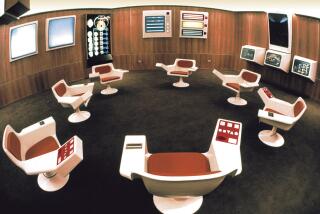Saving Bits and Bytes for History
- Share via
On a muggy autumn morning in 1985, computer scientist John Lee and a small band of researchers gathered on a farm in Virginia and began grubbing through a heap of rusted refrigerators, stoves and ancient radios tossed there decades ago by a scrap dealer.
Buried somewhere in this pile of junk lay pieces of the only Harvard Mark III computer ever built--a house-sized machine festooned with flashing lights and whirring tape reels that Time magazine put on its cover in 1950 as a “thinking machine” that could have “more effect on mankind than atomic energy.”
Lee and his comrades uncovered their first piece in moments--an aluminum arm with a dime-sized slug of steel that was used to read a Mark III memory device.
“All of us were mentally jumping for joy,” Lee said, recalling the excitement of their discovery.
Their joy, however, was short-lived. After a year in which they gathered a few boxes of Mark III pieces, the farm was sold and a house was built on top of the junk pile.
“Gone . . . all gone,” said Lee from his office at Virginia Polytechnic Institute and State University as he gazed at the aluminum arm he had dug up years ago. “Those people have no idea what is under their patio.”
For technology, time has proved to be a cruel master, an insatiable destroyer of what is arguably the greatest revolution of the 20th century. Unlike great literature and art, which grow in meaning and significance over time, old technology has simply become obsolete stuff that takes up space.
Over just the last 50 years, some of the most famous pieces of computing history--devices as revolutionary in their time as Gutenberg’s printing press or James Watt’s steam engine--have been heaped into landfills across the world.
For historians they are painful losses, since many of the pioneers of this revolution are still alive and their creations could have been easily saved if someone had had the foresight to see their significance.
The Harvard Mark III was cut into pieces in 1958 and literally tossed out of the windows of a Navy laboratory after its useful life was over--a few short years.
Others, like one of the computers that created the first links in the earliest version of the Internet, the first transistorized computer (the 1956 TX-0) and the World War II-era British Colossus computers that helped crack the Nazi war codes, are all gone.
Capturing a Piece of the Internet
In many ways, the lightning pace of technological change has begun to rewrite the rules of historical preservation. Historians are being overwhelmed by the volume of inventions that they guess will be important artifacts in the future.
One of the biggest problems they face is figuring how to preserve even a tiny sliver of what has become the most significant technological movement of recent years--the Internet, a sea of data that is re-created and destroyed each second.
“We are in the process of losing our heritage by not preserving it,” said Lee, the former editor in chief of the Institute of Electrical and Electronics Engineers’ Annals of the History of Computing. “It’s being destroyed at a faster rate than ever before.”
If there is a safe and sacred spot for historic technology, it is the Computer Museum History Center in the heart of Silicon Valley at Moffett Field--a former naval air station now run by NASA.
Art has its Guggenheims and Gettys, but for computing technology the Computer Museum is one of the few institutions, along with the Smithsonian, that has even considered technology worthy of collecting.
Its ramshackle buildings speak volumes about the status of technology in the public consciousness.
For the uninitiated, the inside of the museum’s buildings look a lot like a dilapidated warehouse of used office equipment.
In fact, the buildings are a group of old Navy warehouses that have been pressed into service while the museum waits for NASA to begin realizing its long-term plan to convert Moffett Field into a technology business center and museum complex.
In the meantime, the museum is open only one day a week to small groups of visitors who make reservations.
Inside the warehouses, equipment is stacked almost haphazardly on metal racks, and a thick layer of dust covers the heaps of metal electronics boxes, Teletypes, adding machines and old computer monitors.
Parked outside one of its buildings is a silver utility van that looks like any of the numerous work vehicles scooting across Moffett Field. In fact, it is the van used by scientists in the early 1970s to make what some researchers argue was the first true transmission of the modern Internet, using prototype military radios tied into a computer network.
Dag Spicer, a 38-year-old electrical engineer and curator of the museum, said the dilapidated state of tech history is simply a reflection of the warped nature of modern life, in which everything seems focused on the next great thing.
“The problem we face is one of prostalgia--the longing for things not yet invented,” Spicer said.
Spicer said he understands why so many historic devices have been destroyed: Most people probably didn’t even know that many of these machines existed in the first place.
As he walked through the cluttered mess of machines packed into one of the museum’s buildings, he recited the histories of various pieces that would be obscure even to many computer pioneers.
In one building is a 15-year-old Cray-2, a sleek tower of red-and-black metal used at Lawrence Livermore National Laboratory for research into fusion energy, high-energy physics, material science and climate modeling. It was one of the most powerful supercomputers of its time, but--like everything else in this industry--was soon eclipsed by later models. Nearby is a 60-foot chunk of the 1958 SAGE computer, built by IBM as part of an early-warning system for the U.S. Air Force, and a Honeywell Kitchen Computer, a gimmick device for tech-savvy housewives that was sold by Nieman Marcus in 1969 for $10,000 to store recipes.
In comparison with the 4,500-year-old pyramids of Egypt or even the relatively youthful Leaning Tower of Pisa, at just 800 years old, it seems incomprehensible that a bunch of programs and dusty machines that are at most 60 or 70 years old should be worthy of consideration.
But the public appreciation of old technology is changing.
The Internet and the proliferation of computing devices in every nook and cranny of modern life have begun to make collecting computers a hip pastime for newly rich technologists, putting even more pressure on historians to find pieces before they disappear into private collections.
EBay, the online auction company, has a bustling category for vintage computers, although most of the items are relatively common personal computers from the 1980s, such as the Commodore 64 and the IBM PCjr.
A more ominous trend is the growing number of collectors and souvenir hunters who are pouring thousands of dollars into the vintage computer market.
Four months ago, a 4-foot-long piece of the World War II ENIAC, America’s first working digital electronic computer, and many documents from one of its designers, J. Presper Eckert, were sold in an auction for $80,000.
ENIAC, an acronym for Electronic Numerical Integrator and Computer, began life as a secret Army project during World War II to create a machine that could generate huge tables of trajectories for artillery shells.
The machine has always occupied a special place in the hearts of technologists because of how much its designers accomplished using, not silicon chips or even transistors, but vacuum tubes--thousands of them.
The Smithsonian Institution in Washington, D.C., which has a large part of the ENIAC in storage, had to sit on the sidelines in the Eckert auction.
“We just couldn’t afford it,” said David Allison, chairman of the division of information technology and society for the Smithsonian’s National Museum of American History.
Profiting From New Memorabilia
Souvenir hunters also have begun to wake up to the profit potential in selling technology memorabilia in much the same way that previous generations sold signed baseballs and movie star paraphernalia.
One enterprising collector bought a rare Cray-1 supercomputer in 1993 for $10,000 (down from its original $19-million price in 1976) from Lawrence Livermore.
The collector has been selling pieces of its circuit boards for $150. He has since bought five more Cray computers, which he also has been selling as mementos.
“When I bought the machines, no one wanted them, even museums,” said collector Tony Cole, who runs his computing collectibles business out of his San Mateo home. “Now they don’t have the money to buy the stuff. I’m not against them. I do feel bad, but not really bad.”
Spicer remembers one buyer who picked up a rare IBM mainframe with the plan to rip out its electronics and turn it into a rolling mini-bar.
“That’s like cutting off the nose of the Mona Lisa,” Spicer said.
There have been many successful rescues over the decades. Leonard Kleinrock, a professor of computer science at UCLA, managed to save the first computer attached to ARPANET, the precursor of the Internet, by stashing the refrigerator-sized machine in the department’s library for more than a decade.
Gordon Bell, a renowned Digital Equipment engineer who helped design the first minicomputers, saved MIT’s 1951 Whirlwind computer by literally stopping the truck that was taking the machine to the landfill.
But even as historians lament the loss of historic devices to landfills and technology hunters, they are facing a thorny question: In an age of mass production, what exactly is historic?
Most of the early computers, including ENIAC and the Harvard Mark III, were unique, and almost everything about them could be considered groundbreaking.
But by the 1960s, most computers were mass-produced and the key to their uniqueness often lay, not in their hardware, but in their software.
Jonathan Schaeffer, a professor of computer science at the University of Alberta, wrote a checkers program called Chinook that became world champion in 1994. Chinook used one of the most powerful computers of its time, a sixteen-processor Silicon Graphics Challenge computer.
Silicon Graphics lent the machine to Schaeffer specifically for the championships, and after the match it was shipped to a customer. Even for Schaeffer, the loss of such a historic machine was minor.
“I don’t feel any sadness that it is gone,” he said. “In some sense it is historic, but it isn’t unique or anything.”
Perhaps the best-known computer of modern times, IBM’s Deep Blue, which was the first to defeat a chess world champion in match play, was essentially a standard IBM supercomputer with some extra circuit boards for chess analysis.
After defeating world champion Garry Kasparov in 1997, the $2-million IBM computer was scheduled to be shipped off to a customer.
Murray Campbell, one of the IBM researchers who worked on the Deep Blue project, said there was no question that the group would save the special circuit boards and the Deep Blue program. But trying to decide what to do about the computer itself was a more difficult issue.
The IBM researchers finally persuaded the company to give them the computer to use on their next project, developing advanced e-commerce applications.
“Maybe we are being too sentimental, but this is the machine that won the match!” Campbell said.
‘I’m Just One Guy’
Technology is developing so quickly that many of the most important artifacts of the present age have turned out to be devices and programs churned out, not by the dozens or the hundreds, but by the millions.
Allison, of the National Museum of American History, said that just trying to capture a minor part of the outpouring of technology that has characterized the modern era has meant collecting such disparate devices as Apple Computer’s groundbreaking Newton personal digital assistant, a see-through Palm Pilot, two Apple iMac’s, droves of networking equipment from Cisco Systems, an early automatic teller machine and even copies of such popular computer programs as the games DOOM, Quake, Myst and SimCity.
For every collection he starts, a new group of categories seems to pop up. He said he hasn’t even started dealing with such omnipresent devices as MP3 players, Internet cellular phones and Nintendo game machines.
“I’m just one guy,” Allison said. “I don’t even have a PC department. It can be a little overwhelming.”
Except for a project that collected the 1996 presidential Web sites, the Smithsonian has done little to collect pieces of what is undoubtedly the most significant movement in technology of the past quarter of a century--the Internet.
That Herculean task has fallen to the Internet Archive, a nonprofit San Francisco organization that has been working for the last four years on taking snapshots of all the files, pictures and text on the Internet.
The snapshots are largely taken by Alexa Internet, a company that makes Web search and navigation tools. Alexa has crawled the Internet a total of seven times since the company was created in 1996.
“This is going to be an ongoing record of what things were like,” said Niall O’Driscoll, Alexa’s vice president of engineering, explaining that future historians will be able to track such important developments as the start of e-commerce and the growth of companies like Amazon.com and EBay.
But he added that, no matter how complete the archive is in the future, it can never go back and save what was lost before the crawls began, such as the birth of the search engine Yahoo, the rise of Netscape and the outpouring of millions of messages and Web pages from people debating the potential uses of this new medium called the Internet.
“Almost zero has been saved from those times,” O’Driscoll said. “It’s really unfortunate that we don’t have a very good record of those times. It’s probably all gone.”
(BEGIN TEXT OF INFOBOX / INFOGRAPHIC)
A Timeline of Computer History
Historians are overwhelmed by the lightning pace of technological achievement, worrying how, if or what to preserve for posterity. The Computer Museum History Center in the Silicon Valley is trying to change that. Key events in computer history:
1938
* Konrad Zuse of Germany builds the world’s first binary digital computer, the Z1.
1946
* John Mauchly and J. Presper Eckert Jr. finish work on ENIAC (electronic numerical integrator and computer), the first electronic general-purpose digital computer.
1948
* Researchers at the University of Manchester complete the Manchester Baby, the first stored-program electronic digital computer.
1956
* MIT researchers build the TX-0, the first general-purpose, programmable computer built with transistors.
1965
* Digital Equipment Corp. introduces the PDP-8, the first commercially successful minicomputer. The PDP-8 sold for $18,000, one-fifth the price of a small IBM 360 mainframe.
1969
* The firm Bolt, Beranek and Newman installs the first two nodes of ARPANET, the precursor to the Internet. The IMP-1 is sent to UCLA and the IMP-2 to the Stanford Research Institute.
1971
* The Kenbak-1, the first personal computer, advertised for $750 in Scientific American. The machine was designed by John V. Blankenbaker.
1974
* Xerox’s Palo Alto Research Center develops the Alto, the first computer to use a mouse, windows and graphical icons.
1976
* Steve Wozniak designs the Apple I. He and his high school friend, Steve Jobs, sell 220 of the computers to hobbyists.
1981
* IBM introduces its PC, igniting the personal computer industry.
1993
* Mark Andreeson and other researchers at the National Center for Supercomputing Applications release Mosaic, the first Web browser.
1997
* IBM’s Deep Blue supercomputer defeats world chess champion Garry Kasparov.Source: Computer Museum History Center
More to Read
Sign up for Essential California
The most important California stories and recommendations in your inbox every morning.
You may occasionally receive promotional content from the Los Angeles Times.











